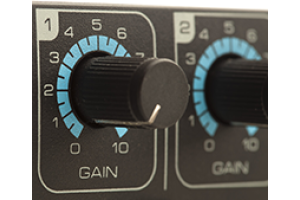Volume/gain/level/attenuation controls
These are terms that are often used interchangeably. When any signal is input to a device, mixer/amplifier, it must be increased in size in order that it can drive a loudspeaker and produce an increase sound level. In electronics when a signal is subjected to this increase in size it is amplified, and the amount is known as the GAIN. In other words, how many times larger it is compared with the original. Usually, the operator isn’t really interested in the actual number so a scale of 0-10 is used. 0 refers to no output at all and 10 is maximum. Sometimes numbers such as 10dB up to 60db may be shown. Although this is interesting to those used to working in dB or decibels, it can simple be accepted that the higher the number the louder the signal will be.
Because these names are usually associated with input or output controls, they are often interchangeable. Increased GAIN means a higher LEVEL which also means the VOLUME is greater.
Less often used is ATTENUATION, which is simply the opposite of GAIN. Sometimes on an input of a mixer there may be a press button which says 20dB ATTENUATION. This simply means that the input signal will be decreased by 20dB when pressed. This is primarily used when a higher level signal is fed into a low level input. 20dB is just an example it can be any number 20dB is 10 times the signal level or if used as an ATTENUATION 20dB is 1/10 of the signal level. Due to the nonlinear way we hear 1/10 of the signal level is a large amount but not enormous.

